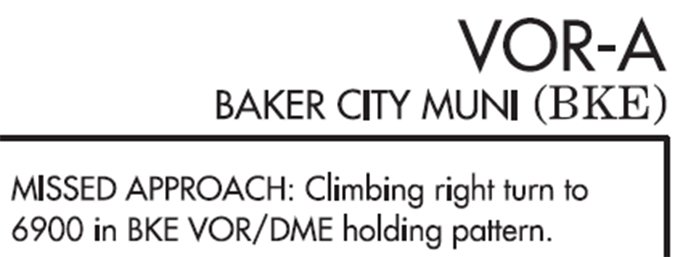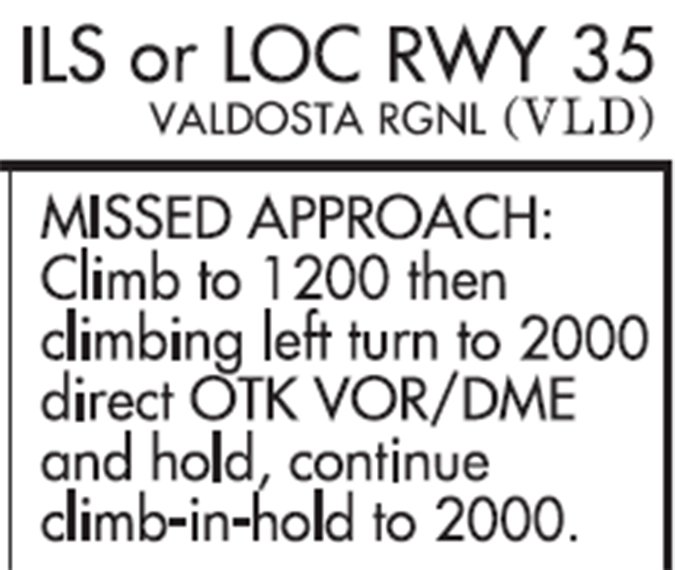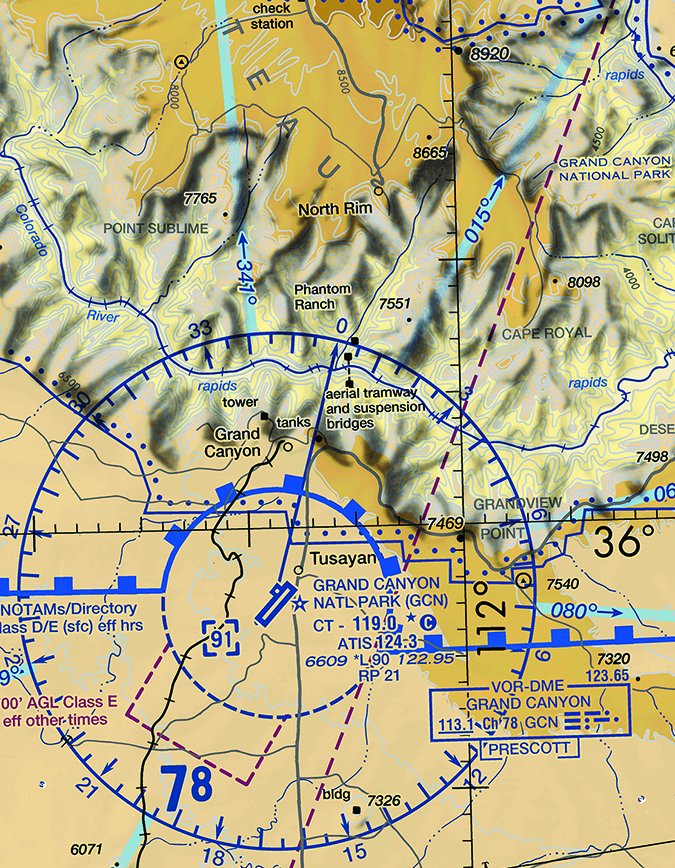Climbing to hold over an airport to wait for better weather or traffic is nearly always referenced against a VOR that is located on or very close to the airport, so you really can’t get lost. Plus, there’s at least one runway right below in case of any issues that might develop.
What’s more, obstacle clearance is straightforward—poles, towers and trees are only so tall and you don’t have to worry about encountering significant terrain rising up from the airport itself. So those missed procedures that require what we know as a climb-in-hold are going to be easy to spot, right? Well, mostly…
The Easy Ones

During an informal survey of pilots asked to compare a sampling of climb-in-hold missed-approach procedures, the one gotcha thrown into the mix was the one that required more than a passing glance at the briefing strip. Naturally, this was the one that could lead to a bad situation. We kind of set these test subjects up for failure by giving them the easy, obvious examples first to lull them into a sense of familiarity.
During the comparison exercise, the gotcha only became apparent after seeing examples of look-alike missed approaches and then asking the right questions and checking the enroute chart.
Here’s missed approach Example 1: At Baker City Muni in Oregon, the VOR-A missed says to make a “climbing right turn to 6900 in BKE VOR/DME holding pattern.” No question here as to how this works.
Example 2: At Valdosta Regional in Georgia, the wording is a bit different when going missed from the ILS 35: “Climb to 1200 then climbing left turn to 2000 direct OTK VOR/DME and hold, continue climb-in-hold to 2000.”

If you start at the DA of 489 (300 feet above the surface), you head out until reaching 1200 feet before turning towards the VOR. If you’re not yet at 2000 before getting to the hold, no big deal —just keep climbing while in the hold. Many missed procedures require climbing straight out to an initial altitude before turning toward the holding fix.
Example 3: “Climb to 4100 in GGW VOR/DME holding pattern.” This is yet another way of describing a climb in hold, but it’s the same idea: Keep climbing in the holding pattern. Despite the different descriptions here, it’s clear in each example what the intent is: Stay safely in the hold as you gain altitude.
At First Glance
Now for the gotcha: Example 4 takes us to the cool-but-complex airspace in Grand Canyon National Park, where the namesake airport (KGCN) offers yet another way to enter an overhead hold.
The GCN VOR/DME is located at the airport on the north side of the single runway. However, the ILS 3 calls for quite a bit more altitude to gain between the missed and the hold. Plus, there’s a slight change in wording that, given the previous examples, will prompt you to examine the procedure more closely.

The straight-in ILS calls for a decision altitude of 6765 feet at 1.7 DME from GCN, a half mile from the threshold. Going missed, the instructions are to “climb to 10000 direct GCN VOR/DME and hold.” Most of the pilots asked to interpret the textual version on its face or just describe the briefing symbols said it appears to have you climb to 10,000 feet, then turn back to the navaid for holding.
But they started asking the right questions, knowing full well that climbing anywhere around the Grand Canyon takes some forethought. A look at the plan view shows the holding track is right there before you as you go missed at the VOR/DME. All you do is get away from the surface (at least 400 feet when missing an ILS) and start the climbing turns —or do you keep climbing first to 10,000 feet, then enter the hold?
The first interesting catch most of the pilots found is that the briefing symbols on the profile view don’t depict a climbing turn as in Example 1, just a straight path to 10,000 feet. What’s more, the text says nothing about turning left or right.
The next point that emerges is that this missed approach requires a gain of 3235 feet to get to the holding altitude. Time for that forethought.
Take A Closer Look

One of the best methods of analyzing any given component of an IAP is to look at the others published for an airport. At KGCN, the missed procedure for VOR 3 has you “climb to 8800 in GCN VOR/DME holding pattern.” (We’ve seen this wording in the Baker City hold.) Going missed at the MDA of 7100 feet, the climb required is not too bad, just 1700 feet to gain.
Compare the plan views of the ILS and VOR missed approaches and you see that the holding fix and track for both IAPs are identical—016 degrees inbound to GCN, 196 degrees outbound, left turns. However, the VOR version includes an arrow depicting a left turn, while the ILS hold does not.
Drop down to the missed briefing symbols on the profile views. Again, they are the same, a straight path to the published holding altitude, 8800 feet for the VOR approach and 10,000 for the ILS. (Note that both holds offer more than 2000 feet of clearance over the obstacle that sits just below.)
On the ILS, the missed instructions say nothing about climbing “in the holding pattern” or “continue climb-in-hold” as you’d expect, although everything points to that. By now, everyone had reached the same conclusion, but the discussion went further for those more curious: What if you climbed straight out ’til you got to 10,000 feet?
Even Closer
To see how big this gotcha can get, we’ll fly this scenario in a Cessna 182Q. Overall, this is a nice climber and doesn’t use much runway for takeoffs and landings. But a warm day in the Grand Canyon should give pause when it comes to estimating climb performance.
The only tools available (besides the airplane itself) that can provide some idea of what to expect are the rate-of-climb performance table from the C182’s POH and a calculator. KGCN’s elevation is 6609, so we’ll start with what’s provided on the performance table: A pressure altitude of 6000 feet, temperature 20 degrees C, airspeed 74 knots. This results in a climb rate of 620 FPM. At 8000 feet, it’s 500 FPM, and at 10,000 feet, it’s 375 FPM.
The GCN VOR/DME is just about 1.5 NM from the ILS 3 MAP when taking into account the MAP and position of the VOR/DME in relation to the runway. In round numbers from 6000 feet, it would take 5 minutes to gain 3200 feet. It would also take 6.24 NM on a straight-out climb to reach 10,000 feet, which does not make sense given the goal to get to the holding fix that’s overhead.
But the real problem with climbing away from the vicinity of the airport becomes evident when you see the ridge that, sure enough, starts about 7 NM northeast of the field.
The nuance here is that for the miss on the ILS, GCN is ahead—thus “direct” while climbing. On the VOR miss, GCN is the MAP so to enter and climb in hold there requires the turn in the plan view.
This just illustrates how critically important it is to consider the context and the big picture when you’re briefing an approach.
Elaine Kauh is a CFII in eastern Wisconsin, where a climb to 10,000 feet gets you a great view of Lake Michigan—and nearby states.





